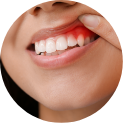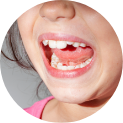Receding Gums
At Scottsdale Family Smiles, we understand the crucial role that gum integrity plays in the overall health of your mouth. In many situations, regular dental care is all that’s necessary to keep gums healthy. However, further intervention may be needed for those whose gums have started receding. Recession is marked by pain near the gum line, sensitivity to hot and cold, and sensitivity during regular cleanings. If you notice heightened sensitivity or recession of your gums, call our office at (480) 607-6937 to schedule an appointment with one of our dental specialists.
What Causes Gum Recession?

Brushing Too Aggressively:
When you brush your teeth too hard or use a toothbrush that’s too firm, you can irritate your gums. Long-term inflammation can cause the gum tissue to pull back from your teeth.

Grinding Your Teeth:
Bruxism, or grinding your teeth, is a primary cause of gum recession. However, many people are unaware that they grind their teeth since they do it in their sleep.

Gum Disease:
This is the most common cause of gum recession. Gum disease can occur at any age, even with good dental hygiene, so it’s critical to seek care if you notice that your gums are red, irritated, or receding.

Tobacco Use:
Smoking or using smokeless tobacco is highly toxic and harmful to your mouth and can directly contribute to gum recession.

Genetics:
In some cases, gum recession can be a genetic issue. If either of your parents or another close family member struggles with gum recession, you may also be at risk.

Misaligned Teeth:
Crooked teeth or a misaligned bite pattern can cause excessive strain on your mouth, which can eventually lead to gum recession.

Hormonal Changes:
Major hormone fluctuations, such as during pregnancy or menopause, can cause inflammation and increase the risk of recession.
Single-Sided vs. Single-Tooth Gum Recession
If you’re experiencing gum recession on only one side of your mouth, it may be due to plaque buildup in that one location. This could indicate that one side of your mouth isn’t being cleaned as well as the other. Additionally, you may suffer from single-sided recession if you only have crooked teeth on one side of your mouth.
While these factors could be the cause of gum recession over a single tooth, single-tooth gum recession is most likely the result of dental trauma. Your gum may have been cut or sustained an injury that failed to heal properly. For example, if you have piercing jewelry through the lips, cheeks, or tongue, the jewelry may have damaged your gum tissue in a specific area.
Evaluating the Impact of Gum Recession
If you notice gum recession in any part of your mouth, we encourage you to call our office to schedule an appointment. The sooner you identify and address recession, the faster you can get relief and prevent further damage. Ignoring your gum recession could eventually lead to tooth loss and worsening gum disease. Your gums will continue to become irritated and inflamed, causing further recession that exposes your teeth and jawbone to serious bacterial infections. Gum disease can be devastating and it will only subside when properly treated. That’s why treating and preventing recession now is key to protecting your smile.

Need Fast Relief?
If you’re suffering from pain associated with gum recession, the first thing to do is to schedule an appointment with a dental professional. In the meantime, you can try these at-home treatments for short-term relief:
- Apply a cold compress to the painful area
- Swish salt water rinse in your mouth at least twice a day
- Oral anesthetic gels to numb the pain
- Over-the-counter painkillers
Prevention & Treatment Strategies
The best way to prevent gum recession is to gently brush around your gum line and keep up with good oral hygiene, including regular cleanings by a professional. However, this may not be enough in some cases. The root cause may be difficult to identify, which is why it’s important to regularly consult a dentist about your oral health and risk of recession. If your recession is severe, you may be a candidate for gum graft surgery.
Dr. Fattah and the team at Scottsdale Family Smiles provide the following treatments for gum recession:
- Scaling and root planing
- Topical antibiotics
- Dental bonding
- Orthodontic treatment
- Activated oxygen/ozone therapy
- Laser bacterial reduction

What Our Patients Are Saying
Receding Gums
Scottsdale, AZ

